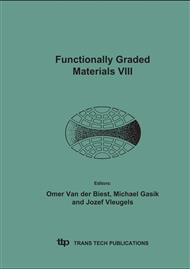p.539
p.545
p.551
p.555
p.561
p.567
p.573
p.581
p.587
Using the Image Analysis Program for Prediction of Thermal Stability Behavior of Refractory Specimen
Abstract:
Most important properties which are usually measured for refractories are work temperature and thermal stability. Thermal stability of the alumina based samples was measured using a standard laboratory procedure, the water quench test ( JUS.B.D.8.319.). ImagePro Plus Program was used for image analysis of microphotographs of the samples before, during and after water quench test. Changes at the surface before, and after cycling were given. Mechanical characteristics were considered such as compressive strength, and dynamic modulus of elasticity. It was measured by resonance frequency measurements, as well as ultrasonic velocity. In this work the correlation between microstructure, ulatrasonic velosity and strength on thermal stability of the sample were investigated. The obtained results were used for validation of the model to predict the thermal stability of the refractory specimen.
Info:
Periodical:
Pages:
561-566
Citation:
Online since:
August 2005
Authors:
Price:
Сopyright:
© 2005 Trans Tech Publications Ltd. All Rights Reserved
Share:
Citation:


